Physical Address
304 North Cardinal St.
Dorchester Center, MA 02124
Knowledge about the management of wounds is a distinct subspecialty requiring knowledge of both normal and nonhealing wound physiology, products to accelerate wound healing, and new therapies for the treatment of recalcitrant wounds. Many subspecialties—such as vascular surgery, plastic surgery, podiatry, and primary care—share a role in managing wounds in the community. Current literature and research regarding wound healing is often published outside of traditional surgical or medical journals, so that many vascular surgeons are not familiar with up-to-date best practices.
In many institutions, surgeons and particularly vascular surgeons are the primary consultants for the management of wounds, as few other physicians train in the evaluation and treatment of wounds. Classifying wounds as arterial, venous, mixed/arterial venous, neuropathic, or vasculitic requires thoughtful evaluation of the wounds but also the patient in total.
One of the most common clinical presentations for patients with peripheral arterial disease (PAD) is a nonhealing ischemic wound. Although revascularization may be required for limb salvage, the meticulous management of the primary wound before and after surgery is critical to the success of limb salvage as well as the time that it will take for a patient to return to function. Wound care after revascularization may be required for months or even years, and a nonhealing wound can lead to limb loss, even if revascularization has been successful.
Patients with PAD who have limb-threatening ischemia often have diabetes. Lower extremity ulcers are not only common in diabetics but they may also develop during the course of treatment. Diabetic wounds require specific management and are often managed by the vascular surgeon.
In the process of limb salvage, vascular surgeons create surgical wounds in ischemic limbs by harvesting vein conduit and exposing distal vessels. These newly created wounds occasionally result in graft exposure or infection or delay the return to normal activity. Knowledge about the methods of minimizing the risk of creating wounds in ischemic limbs and their management is the province of vascular surgery.
Wound healing involves a well-organized, multifaceted series of events beginning after the actual event of wounding and ends with the formation of mature scar tissue ( Fig. 63.1 ). The acute wound is caused by external trauma; in normal healing, the acute injury heals by progressing through orderly phases in a predictable time frame. Chronic wounds, however, do not follow this predictable course of events and should be viewed differently from acute wounds undergoing normal healing. For chronic wounds, health care providers are now beginning to comprehend the complex cellular and biological abnormalities in nonhealing wounds.
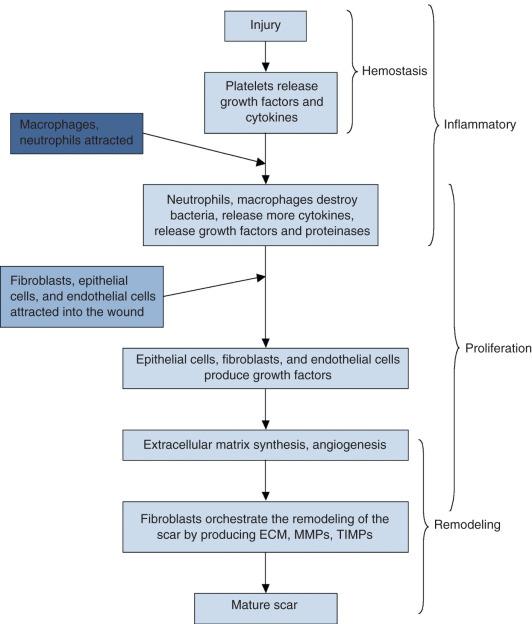
Much of the latest research on wound healing involves investigation of the effects of various cytokines, growth factors, proteinases, and their regulators and how they control the process of wound healing ( Fig. 63.2 ). To understand the effect of these substances on the chronic wound, the normal healing process of the acute wound must be understood. In acute wounds, the healing process begins with tissue injury and progresses predictably through the four phases of wound healing: hemostasis, inflammation, proliferation, and remodeling.
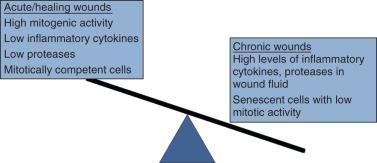
At the time of the initial injury, platelet activation and vasoconstriction occur after injury to the endothelium. Platelet aggregation, vasoconstriction, and clot formation begin the process of hemostasis. A number of soluble mediators are released by the platelets, including platelet-derived growth factor (PDGF), insulin-derived growth factor 1 (IGF-1), epidermal growth factor (EGF), fibroblast growth factor (FGF), and transforming growth factor-β (TGF-β). These mediators are responsible for initiating the healing process. Growth factors stimulate the proliferation of wound cells, act as chemotactant agents, and regulate the differentiated functions of wound cells. Neutrophils and macrophages are recruited to the injured site, attracted by the chemotactant release by the platelets.
Aggregated platelets begin to degranulate and mediators are released that help form the fibrin clot. Initially in the inflammatory phase, there is significant vasodilation, increased capillary permeability, complement activation, and migration of polymorphonuclear neutrophils (PMNs) and macrophages to the site of the wound. The antimicrobial defense and removal of devitalized tissue is initiated by the macrophages and PMNs. As they engulf and destroy bacteria, proteases are released, including elastase and collagenase, which begin the degradation process of the damaged extracellular matrix (ECM) components.
Along with their role in defense and debridement, macrophages and neutrophils induce the formation of granulation tissue by secreting growth factors that stimulate fibroblast proliferation (PDGF), collagen synthesis (TGF-β), and the formation of new blood vessels (FGF). The cytokine IL-β stimulates the proliferation of fibroblasts, and TNF-α and IL-1β stimulate fibroblasts to synthesize matrix metalloproteinases (MMPs).
The proliferative phase begins as the number of inflammatory cells in the wound bed decreases. The synthesis of growth factors continues in the wound bed but is populated by the fibroblasts, endothelial cells, and keratinocytes. Keratinocytes synthesize TGF-β, TGF-α, and IL-1. Fibroblasts secrete IGF-1, bFGF, TGF-β, PDGF, keratinocyte growth factor, and connective tissue factor. Endothelial cells produce b-FGF, PDGF, and vascular endothelial growth factor. The process of cell migration and proliferation continues as the processes of new capillary formation and synthesis of ECM components are begun.
Fibrin and fibronectin form a provisional wound bed matrix. New collagen and elastin and proteoglycan molecules that form the initial scar are synthesized by fibroblasts. Proteases have an essential role at this point. No integration of the newly formed matrix with the dermal matrix can occur until the damaged proteins in the existing matrix are removed. Neutrophils, macrophages, fibroblasts, epithelial cells, and endothelial cells secrete proteases. Key proteases include collagenases, gelatinases, and stromelysins, which are all members of the matrix MMP superfamily, and neutrophil elastase, a serine protease.
In the wound bed, cell proliferation and the formation of new ECM is continuing and sustained by a dramatic increase in the vascularity of the wound bed. The epidermal layer is reformed by the proliferation and migration of epithelial cells across the highly vascularized ECM.
Once the initial scar is formed, the synthesis of ECM continues for several weeks. The newly healed red, raised scar changes over the course of weeks to months to a scar that is less red and may be barely visible. At the cellular and molecular level, the breakdown of the ECM components reaches a balance with the process of synthesis of ECM, allowing remodeling to occur. The increased concentration of fibroblasts and capillaries present in the early phase of healing declines, primarily through apoptosis. In the final remodeling phase, tensile strength reaches a maximum of 80% of the initial strength, as cross-linking of collagen fibrils plateaus.
In contrast to the acute wound, the chronic wound does not heal in a predictable fashion. Lazarus and colleagues define the chronic wound as one in which the normal process of healing has been disrupted at one or more points in the phases of hemostasis, inflammation, proliferation, and remodeling. Chronic ulcers are characterized by defective remodeling of the ECM, a failure to epithelialize, and prolonged inflammation. In the chronic wound, fibroblasts do not readily respond to growth factors such as PDGF-β and TGF-β; this failure to respond is hypothesized to be due to a form of cellular senescence. Hyperproliferation at the wound margin interferes with normal cellular migration across the wound bed, probably because of inhibition of apoptosis within the fibroblasts and keratinocytes.
The phases of wound healing are replete with factors that have played important roles in the progression of wound healing; therefore any alteration in one or more of these components may interfere with the progression of healing. Growth factors such as PDGF, EGF, bFGF, and TGF-β are present in the chronic wound, but the levels remain constant rather than displaying the variation seen in normal acute wound healing. The proinflammatory cytokines—such as IL-1, IL-6, and TNF-α—remain elevated in chronic wounds compared with the normal, acute wound, where a dramatic decrease is seen during healing, because there is a reduction in the inflammatory state.
Several studies have shown that chronic wounds stall in the inflammatory phase of the wound healing process. This phase is most often associated with an increased amount of exudate, postulated to be from infection, heavy colonization, or from reaction to increased necrotic tissue in the wound bed. The amount and character of fluid produced by the chronic wound can severely impede and even reverse the healing process.
Studies investigating chronic wound effluents have provided increasing evidence that the cellular and molecular environments are substantially altered in chronic wounds. Bucalo and colleagues collected exudate from venous ulcers and examined the effects of chronic wound fluid on the proliferation of dermal fibroblasts, microvascular endothelial cells, and keratinocytes in culture. This study found that wound fluid is not only cytotoxic, but that it inhibited or failed to stimulate the proliferation of dermal fibroblasts, endothelial cells, and keratinocytes. Fluid from acute wounds, in contrast, has been found to stimulate fibroblast proliferation. Proteases in chronic wound fluid have also been shown to degrade growth factors such as PDGF and TGF-1.
MMPs are a necessary component of the wound healing process and have an important role in cell migration and modification of the ECM. If the regulation of these protease molecules is disrupted, excessive MMP production may lead to degradation of the ECM, preventing cellular migration and attachment and ultimately causing tissue destruction. It has been shown that MMP activity is significantly elevated in a high percentage of chronic wounds when compared with acute wounds, suggesting dysregulation in chronic wounds ( Fig. 63.3 ). The activity of these proteases decreases consistently in patients whose ulcers progress from a nonhealing to a healing phase.
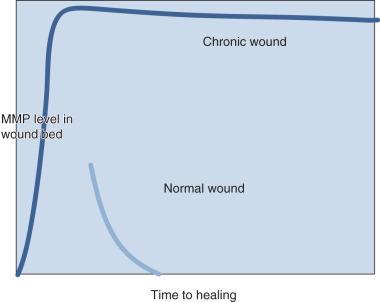
The chronic wound can also be heavily colonized or infected by bacteria that can substantially increase the amount of exudate. Thus a copious amount of exudate produced by the chronic wound, whatever its cause, can be a barrier to healing.
Chronic wounds are the result of altered cellular and molecular processes. Hence wound management must focus on both the wound and the patient as a whole. The goal of wound management is to attain a healthy, well-vascularized granulating wound bed. For this to happen, factors that can impede healing must be addressed. The way in which chronic wounds are viewed and managed should be based on a model that is both different from the acute wound paradigm and representative of the complex nature of nonhealing wounds.
Wound bed preparation has become part of the standard nomenclature in wound healing. The concept of wound bed preparation is the management of a wound in order to accelerate endogenous healing or to facilitate the effectiveness of other therapeutic measures. The main barriers to healing in a chronic wound are necrotic tissue, high bioburden, increased exudate, and altered composition of exudate. The goal of wound bed preparation is to remove or reduce these barriers to healing by using ongoing debridement, reduction of bacterial burden in the wound bed, and management of exudate.
Identification of patient factors that would act as an impediment to healing is an essential component of the healing paradigm. The presence of diabetes, renal disease, heart disease, or liver disease can have detrimental effects on wound healing. Autoimmune diseases such as scleroderma, rheumatoid arthritis, vasculitis, or lupus erythematosus will deter wound healing. Systemic steroids, immunosuppressant medications, and nonsteroidal antiinflammatory drugs will also interfere with the healing wound.
The nutritional status of the patient is an overlooked factor in wound healing. Protein-calorie malnutrition can have devastating effects on the integrity of the body and on any wounds the patient might have. Protein-calorie malnutrition is defined as insufficient intake of both protein and calories. In protein-calorie malnutrition, morbidity and mortality increase as a result of the proportionate decline in body weight. A decrease in lean body mass of greater than 10% is associated with compromised wound healing despite therapeutic interventions. Once depletion of lean body mass reaches 30%, the wound becomes a secondary issue as the body seeks to restore and replenish lost muscle. Correction of any nutritional deficit should begin at the first visit and be maintained throughout the wound healing process. Assessment of dietary intake, including vitamin supplementation, is a necessary part of any wound healing assessment. Appetite stimulants, such as megestrol (Megace), may be helpful. If assessment shows moderate to severe protein-calorie malnutrition, supplementation with oxandrolone has been shown to be beneficial to facilitate restoration of lean muscle mass.
Accurate classification of the etiology of the wound is the basic starting point for proper wound care. For example, improper classification of active pyoderma gangrenosum may result in improper debridement or compression of ischemic wounds. Basic history taking is critical: How long has the wound been present, how did it start, what has been the progression, and how much pain exists? What aggravates or relieves the pain? What are the associated diseases, such as peripheral arterial or coronary artery disease, type 1 or 2 diabetes, or rheumatoid arthritis?
Assessment of the wound includes the location, size, depth, and color of the wound bed ( Table 63.1 ). A cotton swab has been shown to accurately gauge the depth and involvement of deep structures. The depth of a wound can be used to predict the likelihood of healing without extensive debridement of tendon or bone. The most common classification system of diabetic lower extremity wounds is the Wagner system, which grades the depth from superficial skin involvement to a deeper level, involving tendon and bone.
| Category | Observation to Be Documented |
|---|---|
| Wound size | Length, width, depth, area, volume |
| Undermining presence, location, measurement | |
| Appearance | Granulation tissue; slough, necrotic, eschar; friability |
| Exudate | Amount, color, type (serous, serosanguineous, sanguineous, purulent), odor |
| Wound edge | Presence of maceration, advancing epithelium, erythema, even, rolled, ragged |
These variables should be photographed, measured, and recorded. The amount and type of exudate should also be assessed. Associated signs—such as callus surrounding the ulcer, skin changes in the gaiter (ankle) distribution, peripheral neuropathy, and ischemic (trophic) changes—should also be noted and recorded.
Three questions must be answered through diagnostic studies. First, what is the depth of the wound? Depth determines treatment, because involvement of deep structures such as tendon or bone reduces the likelihood of healing without removal of the deep tissue and increases the risk of an ascending infection along tendon sheaths. Subfascial infection is particularly worrisome in diabetic patients, who have reduced sensation of the foot and a reduced ability to fight infection. The simplest test of depth is to probe the wound to determine whether tendon or bone is involved. This inexpensive and simple method has been shown to be as reliable as more expensive tests in determining the presence of osteomyelitis. Other tests such as plain radiographs and bone scans have less sensitivity and specificity than a magnetic resonance imaging (MRI) scan ( Fig. 63.4 ). All these tests have false negatives and positives, so that surgical debridement may be required to determine the presence of deep infection and osteomyelitis by bone biopsy and culture.
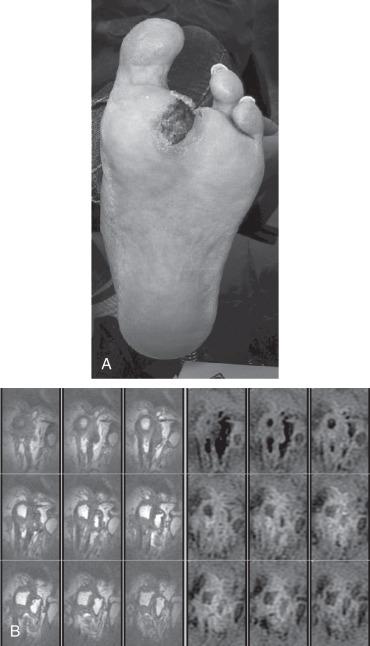
Second, is the wound infected? The differentiation between colonization, cellulitis, abscess, and osteomyelitis is critical for optimal wound management. The degree of bacterial involvement is difficult to quantify and requires clinical acumen. Quantitative cultures are often difficult to obtain and have more use in research than in daily clinical decision making.
Wounds are not sterile and colonization is normal. A wound culture will have multiple skin organisms and there may be no clinical signs of infection, such as erythema, swelling, and pain. Clinically significant bacterial involvement is seen with cellulitis, increasing wound pain, wound enlargement, and increasing tissue necrosis. Plain film of the bone in a patient with osteomyelitis becomes positive in the late stages, long after osteomyelitis is established, whereas MRI scan has been shown to be reliable for determining osteomyelitis and detecting early signs, such as changes in marrow intensity, periosteal reaction, and cortical erosion.
Third, is the limb ischemic and does it have adequate blood flow to heal the wound? Adequate tissue oxygenation must be present for wound healing. Oxygen is available bound to hemoglobin and dissolved in plasma. In chronic wounds, plasma-dissolved oxygen can be adequate for wound healing assuming that perfusion of the tissue is satisfactory.
Assessment of the large vessel vascular supply is a critical component of the examination. A palpable pulse indicates a blood pressure of greater than 80 mm Hg in the foot and 70 mm Hg in the hand. If a pulse is not easily palpable, use of a vascular laboratory examination is essential. Doppler waveforms and ankle-brachial index (ABI) as well as plethysmography ( Fig. 63.5 ) can be used with transcutaneous pressure of oxygen (TcPO 2 ) and skin perfusion pressure to determine the adequacy of blood supply. In patients with falsely elevated “stiff” arteries (high ABI with poor Doppler signals), pulse volume recordings, Doppler waveforms, and toe pressures are more reliable.
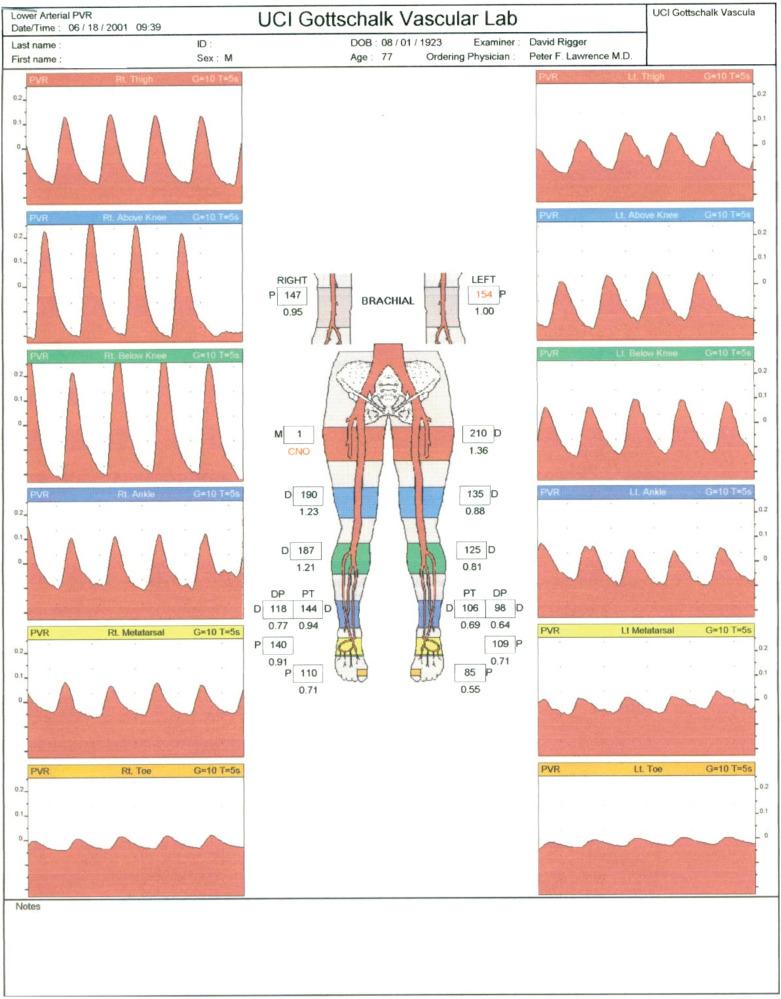
Normal acute wounds usually have oxygen tensions (TcPO 2 ) of 60 to 90 mm Hg, whereas chronic nonhealing wounds are most often associated with varying degrees of hypoxia because of low oxygen tension and poor blood perfusion. A tissue oxygen tension of greater than 40 mm Hg is adequate for wound healing. Tissue oxygen levels of less than 20 mm Hg in the wound bed are usually associated with failure to heal. When there is inadequate blood flow or perfusion pressure for wound healing, treatment must be directed at increasing the perfusion by revascularization.
Become a Clinical Tree membership for Full access and enjoy Unlimited articles
If you are a member. Log in here